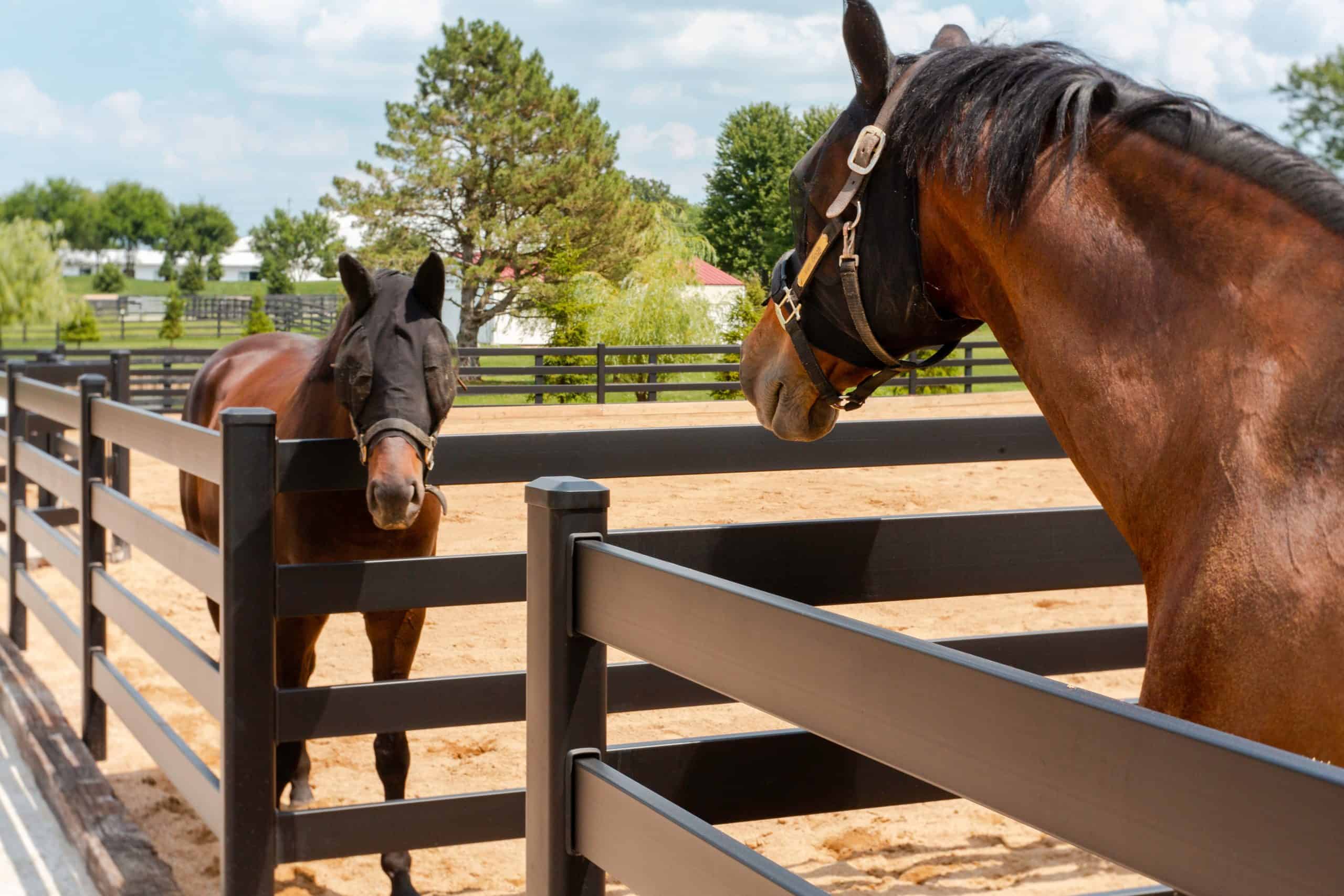When you’re investing in fencing for your property, you’re not just building boundaries—you’re building a legacy. If you’ve ever had to replace a failing fence line or spent countless weekends patching up weather-worn sections, you know that choosing the right material isn’t just about today’s cost: it’s about tomorrow’s peace of mind.
We’ve spent over two decades working with ranchers, horse owners, and property managers across every climate this country has to offer. From the harsh winters of Montana to the unforgiving sun of Texas, we’ve seen firsthand how different fence materials stand up (or fall down) against time and the elements.
Ultimately, the thing you probably care about the most is what is the most durable fencing material.
Below, we’re cutting through the marketing hype to give you the unvarnished truth about fence material durability. We’ll share real info from working ranches, break down the science behind material degradation, and help you understand exactly what you’re investing in.
Whether you’re fencing in prized horses, protecting livestock, or securing your property, you deserve to know what’s really going to stand the test of time.
TLDR: What’s the Most Durable Fence Material?
For those who want the straight answer: steel fencing is the most durable material on the market in 2025. Premium steel fencing systems outlast traditional materials by decades, with verified lifespans exceeding 50 years when properly installed and maintained.
Here’s what sets steel apart:
- Virtually immune to rot, rust, and pest damage when properly coated
- Maintains structural integrity through extreme weather conditions
- Requires minimal maintenance over its lifetime
- Highest impact resistance of any fencing material
- Outperforms in both cold and hot climates
Still, not all steel fencing is created equal. The difference between premium steel fencing and budget options is significant, especially when it comes to coating quality and installation methods. Your specific needs, climate, and property conditions still matter. And yes, the initial investment is higher than traditional materials.
For most property owners, the durability advantage of steel makes it worth the upfront cost. But if you want to understand exactly why (and see how other materials compare), keep reading.
Comparing Major Fence Materials
Steel Fencing
No surprise here—steel leads the pack in durability. Modern steel fencing systems have come a long way from the rusted-out pipe fencing you might remember from your grandfather’s ranch. Today’s premium steel fencing uses advanced coating technologies and engineering that simply didn’t exist a decade ago. We’re seeing these fences hold up 30-40 years with minimal maintenance (and that’s in harsh conditions).
Wood Fencing
Wood horse fences have been the go-to for generations, and for good reason. It’s natural, readily available, and when properly treated, can last 15-20 years. But let’s be honest—that lifespan assumes regular maintenance and ideal conditions. In wet climates or areas with aggressive pest populations, you’re looking at significantly shorter lifespans. Even pressure-treated lumber eventually succumbs to the elements.
Vinyl Fencing
Vinyl makes big promises about being maintenance-free, and in some ways, it delivers. You won’t deal with rot or need to repaint. But here’s what the brochures don’t tell you—vinyl becomes brittle over time, especially in cold climates. Impact resistance decreases year after year, and when it fails, it fails catastrophically. We’ve seen too many vinyl horse fences shatter during harsh winters or heavy storms.
Aluminum Fencing
Aluminum offers good corrosion resistance and a decent lifespan, but it’s not built for the demands of a working ranch or farm. It simply doesn’t have the structural strength to handle livestock pressure or impacts from equipment. It’s a solid choice for residential properties, but for agricultural use? You’re asking for trouble.
Composite Fencing
The new kid on the block, composite materials promise the best of both worlds: the look of wood with the durability of synthetic materials. Reality? They’re still relatively unproven for long-term durability. Early generations are showing signs of UV degradation and moisture absorption issues. The technology’s improving, but we’re not ready to bet the farm on it just yet.
Material-Specific Challenges
Steel’s Weak Points
Even steel isn’t invincible, but its challenges are predictable and preventable. The main concern? Coating failures at connection points and any spots where water can pool. Premium steel fencing systems address these issues through advanced coating technologies and smart design, but budget options often cut corners here. Ground contact zones are another critical area: poor installation can accelerate corrosion where posts meet soil.
Wood’s Battle Against Time
Wood fights a constant war on multiple fronts: moisture, insects, and UV damage. Even pressure-treated lumber eventually loses its protective compounds. We’ve seen posts rot from the inside out while looking perfectly fine on the surface. The most vulnerable spots are ground contact areas and any horizontal surfaces where water can sit. That classic wood fence might look great for the first few years, but by year 10, you’re typically dealing with regular repairs.
Vinyl’s Hidden Vulnerabilities
Temperature fluctuations are vinyl’s worst enemy. We’ve watched vinyl fences become increasingly brittle in cold climates, leading to sudden failures during winter storms. UV exposure is another silent killer, gradually breaking down the material’s structure. And once a vinyl fence starts to fail, you can’t just replace a section—visible differences between old and new panels mean you’re often looking at replacing entire runs.
Aluminum’s Structural Limits
While aluminum resists corrosion well, its strength-to-weight ratio tells the real story. We’ve seen aluminum fencing bend under pressures that barely phase steel. The connections between panels are particularly vulnerable. Once they start to loosen, the entire fence line’s integrity is compromised. Plus, luminum’s high thermal expansion rate means significant movement between seasons, stressing every connection point.
Composite’s Growing Pains
The newest materials often face the oldest problems. Composite fencing can absorb moisture over time, leading to swelling and internal degradation. We’re seeing first-generation composite fences show their age through color fading, surface deterioration, and structural weakening. The industry’s still working out these kinks, but for now, long-term durability remains a question mark.
Maintenance Requirements
Let’s break down what you’re really signing up for with each fencing material. Here’s the straight truth about what each requires to stay standing and looking good.
Steel Fence Maintenance
- Annual inspection of connection points and coating integrity—about 1-2 hours per 1,000 feet
- Spot touch-up of any scratches or coating damage with manufacturer-approved products
- Basic cleaning if desired (mainly aesthetic)—pressure washing every 2-3 years
- Checking post stability and ground conditions every spring
- Lubrication of any gates or moving parts once per year
Wood Fence Maintenance
- Full inspection every 6 months for rot, insect damage, and loose boards—3-4 hours per 1,000 feet
- Resealing or restaining every 2-3 years to prevent weathering
- Replacement of damaged boards as needed (expect 5-10% annually)
- Post stability checks after every major storm or freeze
- Complete re-treatment every 5-7 years
- Regular vegetation control around posts to prevent moisture trap
Vinyl Fence Maintenance
- Cleaning at least twice yearly to prevent staining and algae growth
- Annual inspection for cracks, particularly after winter
- UV protectant application every 2-3 years in high-sun areas
- Checking and tightening of all hardware annually
- Immediate repair of any cracks to prevent spread
- Panel realignment after ground shifts or major temperature changes
Aluminum Fence Maintenance
- Annual inspection of all connection points—2-3 hours per 1,000 feet
- Checking for bent sections after any impacts
- Regular cleaning to maintain appearance
- Hardware tightening every spring
- Touch-up painting of scratches to prevent corrosion
- Ground stability checks around posts twice yearly
Composite Fence Maintenance
- Deep cleaning once yearly to prevent mold and mildew
- Inspection for water damage and swelling every spring
- UV protectant application every 2-3 years
- Hardware inspection and tightening annually
- Checking for thermal expansion issues seasonally
- Immediate attention to any signs of delamination
Choose Buckley Fence for the Most Durable Fencing Materials
At Buckley Fence, we’ve dedicated ourselves to providing the most durable fencing solutions in the industry, backed by engineering that simply won’t quit.
Our premium steel fencing systems aren’t just built different: they’re built better. Every component, from our proprietary coating technology to our precision-engineered connections, is designed with one goal: to be the last fence you’ll ever need to install.
We’re not just manufacturers. We’re ranchers, horse people, and property owners ourselves. We understand that your fence line is more than just a boundary. It’s an essential part of your operation’s infrastructure and your property’s legacy.
Remember, the most expensive horse fence is the one you have to install twice. Let’s get it right the first time. Contact us today for a free quote, and let’s start building you a fence with the most durable materials on the market.



